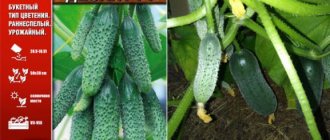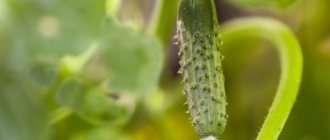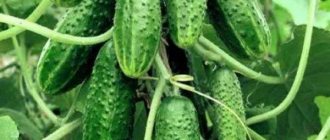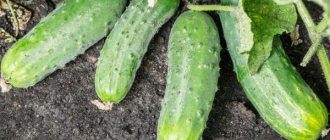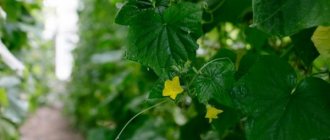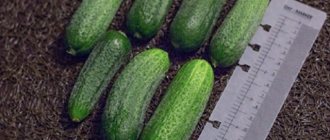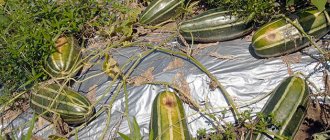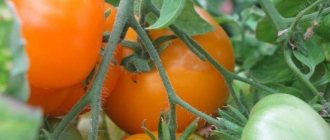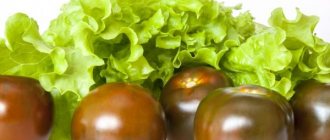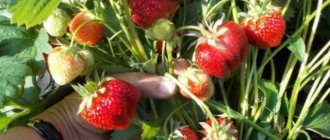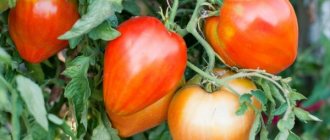The best cucumber seeds for open ground
Cucumber is a vegetable that people enjoy eating raw and canned. Its growing season is quite short, so it is important for every gardener and farmer to know which cucumber seeds are the best for open ground. The choice of seed directly depends on the composition of the soil, the region where it will grow, and the climate.
Types of soil for growing cucumbers
Cucumber seeds for open ground are selected based on the natural features of the area and the location of the garden. This plant is quite capricious, requires warmth, good moisture and loosening of the soil, does not tolerate sunlight well, but its taste and beneficial properties more than cover all the time spent on care.
Cucumbers grow on almost any type of soil, but are less capricious in light soil, rich in fertilizer, with good drainage and aeration. It should be remembered that you should not sow this vegetable in the same place more than once every five years. Therefore, it is necessary to prepare the next planting in advance by adding organic fertilizers, which accelerate the ripening of beautiful fruits and improve their taste.
Cucumber sprouts
Planting sprouts in open ground speeds up the first harvest by two weeks. This plant is capricious, so self-pollinating cucumber seeds for open ground are suitable for seedlings. These include the varieties “Boy with Thumb F1”, “Amur F1”, “Lesha F1”, “Magnat F1”, “Pasadena F1” and other parthenocarpic species. These hybrids have mostly female flowers, do not require the presence of bees for pollination, and are unpretentious.
Cucumber seeds for open ground must be prepared before planting them as seedlings. Since the stems of the plant are very tender, it is recommended to “harden” them and protect them from pests. Many gardeners and farmers prefer to buy hybrid varieties, but if the seed is not one of them, then it is better to take precautions.
To do this, self-pollinating cucumber seeds for open ground are pre-soaked in a weak solution (2g per 200 ml of water) of potassium permanganate. The water should turn out pink. They should be kept for up to 30 minutes, then wrapped in gauze and rinsed for several minutes under running water. This will strengthen the future plant against an aggressive external environment.
The next step is for them to germinate. To do this, seeds for open ground can be spread on a slightly moistened piece of cotton cloth, covered with another moistened material, such as gauze. Within 2-3 days they will “hatch”, and during this time the fabric should be periodically moistened with water. It is important not to overfill them and keep them in a warm place.
“Hardening off” seedlings
To “guess” the timing of growing sprouts, you should know approximately when the temperature of the earth warms up to +15 - 16 degrees. If it is the end of May, then cucumber seeds for open ground are planted at the beginning of the month. The plant is very sensitive to cold, so replanting is stressful for it. Even if the earth warms up sufficiently during the day, it is better to “wrap” the sprouts in film at night.
To obtain strong seedlings, it is advisable to plant each seed in a separate, preferably paper, cup, peat tablets or pots. To prevent the stems from stretching upward too quickly, there must be enough lighting. A window sill on the sunny side of the house is suitable for this, and if this is not possible, then fluorescent lamps should be used. It is also necessary to ensure that the soil or peat is sufficiently moist, but do not flood it with water. Humidification is carried out 1 or 2 times a week, depending on the air temperature in the house. It is better if the room is +18 or higher during the day, and +14, +15 degrees at night. A couple of weeks after sowing, two strong leaves will appear on the stem, then they, together with a glass or peat pot, can be transplanted into the ground.
Varieties of cucumbers
If you think about which cucumber seeds are the best for open ground, then you should look at self-pollinating species, and also decide on the ripening time. This directly depends on climatic conditions, the length of the season and the location of the site. The short summer period requires a different approach to planting and caring for plants than in early spring or warm weather until mid-September.
If the garden is located on the north side, then the best cucumber seeds for open ground are from colder regions of the country. This could be “Farmer”, early “Altai”, “Admira F1”, “Bidretta F1”. They are distinguished by increased endurance to the external environment, good yield and excellent taste. Even if the summer turns out to be cool, they will delight you with abundant crispy fruits.
Varieties of cucumber seeds for open ground can be early-, mid- and late-ripening. Of the “early” varieties, “Muromsky” is considered the most popular, as it produces a harvest already on 35-40 days.
It is better to sow into the ground in the last ten days of May or early June. Whatever the “hardened” plant, a film should be used, covering it at night to preserve the seedlings until the heat is fully established. Before planting, the seeds should be pre-soaked so that they swell and “hatch”. This will speed up the process of the first shoots appearing.
Sowing cucumbers in the ground
Site preparation begins two weeks before sowing. The land should be fertilized, for which you can use compost, manure or organic fertilizers. It is enough to scatter them over the chosen place, level them with a rake and leave them for several days.
Before planting, you need to use a hoe to make grooves or holes and treat them with Energen plant growth stimulator at the rate of 2 capsules per 10 liters of warm water. The holes should be watered generously with the solution during sowing.
Cucumber seeds for open ground, reviews from gardeners confirm this, it is better to throw 3-4 pieces at a distance of 10 cm from each other into one hole. After the seedlings emerge, they need to be thinned out and strong stems left for further growth. Each plant can be covered with a jar for the first week to protect it from the night chill.
Variety selection criteria
To understand which good cucumber seeds to buy for open ground, you need to take into account several important properties of the plant:
- the choice of variety is carried out depending on climatic conditions: for a short summer - these are early ripening cucumbers, for a long and hot summer - later types;
- duration of fruiting of the plant;
- taste qualities of fruits and their purpose - pickling or salads;
- cucumber sizes;
- self- or bee-pollinated varieties;
- disease resistance;
- immunity to external adverse conditions - drought, cold, lack of regular watering.
Having identified the criteria, it is easier to decide on the choice of specific types of seeds.
Early ripening of cucumbers
Early ripening varieties for sowing in open ground include:
- “Aquarius” has a high yield and is used both in salads and for pickling.
- “Vyaznikovsky” cucumbers bear fruit for a long time, have neat fruits and are suitable for pickling in barrels.
- "Herman F1" is resistant to diseases and is recommended for those areas where cucumbers were already growing and were sick. It should also be planted if diseases plague neighboring lands for better crop safety. This hybrid species is good for preservation.
- "Kumanek F1" is a bee-pollinated early variety, suitable for arid areas or vegetable gardens without regular watering. It also “feels” good in cool and “wormy” summers.
- “Siberian Yard F1” gives the fastest germination, early harvest and long fruiting season. It is popular among housewives for pickling and canning. Its peel gradually lets the brine through, which gives a uniform and moderately rich taste.
These descriptions fully confirm the reviews that gardeners leave.
Mid-season cucumbers
These types include:
- "Lord F1" is a bee-pollinated species that produces high yields and is resistant to diseases such as powdery downy mildew. It has neat fruits 10-12 cm in length, which are good for pickling and salting in barrels.
- “Farmer F1” is suitable for gardeners whose plots are located in a fairly cool climate or on the north side. Gives a plentiful and long-lasting harvest with greens up to 12 cm, suitable for pickling.
- "Regina F1" pleases with the first harvest 50 days after planting; it has neat, tasty fruits that are used for salads.
- "Marinda F1" is recommended for lovers of crunchy cucumber. The variety is resistant to pests and diseases, has high yields, and is perfect for pickles and preservation.
Branching of cucumbers
Another indicator when choosing seeds is branching. Plants with active stem formation are suitable for open planting, such as “Phoenix”, “Phoenix 640”, “Maryina Roshcha F1”, “Chistye Prudy”, the main feature of which is prolonged fruiting, right up to autumn frosts. An abundant harvest and tasty greens without bitterness make them the favorites of those gardeners who prefer to collect cucumbers on the ground rather than install trellises. The only requirement of these species is the allocation of a large space in which the stems will form.
Selecting a variety according to purpose
Many summer residents prefer to plant universal varieties that are suitable for salads, pickling and pickling. This species includes “Farmer”, which is famous, in addition to its excellent taste, for its high yield - up to 14 kg of fruits per 1 m2.
Cucumbers for salads are distinguished by their soft and delicate skin, juicy pulp and are loved by housewives for their rich aroma. These include “Nugget”, which produces a large number of greens suitable for salads and canning.
Cucumbers for pickling in barrels usually have thicker peels, which are gradually soaked in brine. This helps maintain their crispy qualities.
When choosing seeds, you need to focus on the desired end result, taking into account local field conditions.
syl.ru
The main advantages of the variety
Experts include the main advantages of the cucumber hybrid Herman F1:
- early ripening of greens;
- good yield;
- fruits are smooth, cylindrical in shape;
- good taste of ripe greens;
- the harvested crop easily tolerates transportation over different distances and can be stored for a long time without changing color;
- ripe greens are universally used, they can be used fresh and also used for preservation;
- resistance to most diseases.
Cucumber Herman F1
Many vegetable growers note that transplanted seedlings of this hybrid may not take root well in a new place. Therefore, it is recommended to replant the seedlings together with a large lump of earth so that the root system is not injured during replanting. Also, the relative disadvantages of the variety include the rather high cost of seed material.
Related article:
Cucumber Siberian Garland F1 – description and characteristics of a super-yielding hybrid, reviews
Review of the best varieties of self-pollinating cucumbers
The history of the development of this vegetable crop goes back more than 6000 years. Some call this plant a vegetable, others a “false berry.” The ancients knew its medicinal properties and used the pulp of this plant to cleanse the body. After all, it contains more than 70% water. Its “fruits” are traditionally eaten unripe when they are green. They improve metabolism in the body, promote good appetite, and improve heart and kidney function. Cucumbers are loved by many - fresh, canned, pickled, in salads and just like that.
Varieties of self-pollinating cucumber varieties
Over such a long period of existence of cucumbers, a huge number of varieties of this crop have been bred - hybrid, non-hybrid, medium-, large-fruited, gherkins and many others.
Within the boundaries of each variety there is a division into male, female and mixed individuals of this culture. This division is very important for the gardener - which variety to give preference to. Most of the random seed material that a gardener receives from seed cucumbers contains preparations in which either male or female traits will predominate. Accordingly, bees will be required in the pollination stage.
Self-pollinating cucumbers are considered more productive. They contain both male and female reproductive organs on the flowers. Therefore, the likelihood of germination and fruit appearance in such plants is much higher. It is better to take cucumber seeds for a greenhouse so that they are self-pollinating, that is, so that the plant has both male and female traits. This way you can save money on your next landing.
Different cucumbers differ in their taste; some are best eaten fresh and good in salads, while other varieties are bred specifically for canning. This is largely determined by the type of variety. Early self-pollinating cucumbers are more tender than late ones. Most often they are consumed fresh. Middle and late ones are more universal.
Self-pollinating cucumbers for open ground
Growing self-pollinating cucumbers for open ground is easy! Planting seeds in open ground is a traditional form of cultivating this crop. This is how you can grow most varieties of self-pollinating cucumbers. To care for self-pollinating cucumbers for open ground, it does not require as much expense as for greenhouse ones. On the other hand, the amount of harvest is several times less. These cucumbers need a lot of heat and plenty of water.
Most varieties of self-pollinating cucumbers are universal, but there are also those that are intended for growing in open and protected ground. These are varieties such as Gerda, Friendly Family, Connie and others.
- The variety "Gerda" belongs to the so-called mid-early varieties of self-pollinating cucumbers. Designed for cultivation in open and protected ground. Its ripening period is about 40 days. Gives high germination rate, the number of ovaries per node is from 3 to 5. “Gerda” is a gherkin variety. The greens themselves grow up to 10 centimeters long. This variety is resistant to powdery mildew and other diseases. This variety is universal; cucumbers can be eaten both fresh and canned.
- “Friendly Family” is an equally interesting variety of self-pollinating mid-early cucumbers. When mature, the fruits reach a length of 12 centimeters. Fruiting is achieved in 45-46 days from the moment the greens appear. It is resistant to diseases, the greens are dense and non-bitter. This variety is recommended for canning and pickling.
Self-pollinating cucumbers for the greenhouse
Many people believe that greenhouse cucumbers are less healthy than those grown in open ground. However, with proper application of fertilizers and compliance with all conditions, greenhouse vegetables retain both their taste properties and do not harm human health. In addition, self-pollinating cucumbers grown in a greenhouse produce a much larger yield than their counterparts cultivated in open or protected ground.
Thus, in an ordinary winter greenhouse the yield of cucumbers is on average 32-34 kg/m2, while in open ground during the season it is up to 3 kg per 1 square meter.
On the other hand, setting up a greenhouse is much more expensive than preparing a plot of land, but in total, the benefits of growing greenhouse cucumbers are greater.
The most suitable varieties of self-pollinating cucumbers for greenhouses include varieties such as “Emelya”, “Zozulya”, “Zyatek” and many others.
- “Emelya” is an early-ripening, early-medium variety, intended primarily for greenhouses and greenhouses. It has a good yield - 13-15 kg/m2. The first cucumbers can be harvested after 30-40 days. The culture is distinguished by its rich green color and high taste. This self-pollinating hybrid is disease-resistant and cold-hardy.
- “Zozulya” is one of the most popular greenhouse hybrids in our country. Due to the predominance of female flowers, it is highly productive. The yield of self-pollinating cucumbers of this variety reaches 24-26 kg/m2. The fruits are medium and large, reaching a maximum weight of 280 grams. It has a medium degree of branching. New seed samples are resistant to diseases - olive spot, cucumber mosaic virus and others. Excellent canning.
Universal self-pollinating cucumbers
Most modern varieties of self-pollinating cucumbers are universal; they can be planted both in open ground and in a greenhouse. It should be taken into account that sometimes parthenocarpic varieties are also classified as universal self-pollinating varieties. These are “false” self-pollinated varieties. They do not have male flowers, but they do have female flowers. This helps the formation of greens without pollination. These plants have no seeds.
Universal varieties of cucumbers suitable for planting both in the ground and in a greenhouse include the following: “Spring”, “Herman”, “Clavdia”, “Crispina”, “Ant”, etc.
- The name of the variety “Spring” speaks for itself. This is an early universal parthenocarpic hybrid. The greens of this variety are short - up to 8 cm, the plant is medium-branched, the average yield of the variety is 15-17 kg/m2. Cucumbers have a sweetish taste, and the fruits are disease-resistant.
- The Dutch variety “Herman” has absorbed all the achievements of European breeders. Just like “Spring”, it is early ripening. However, it belongs to the universal, truly self-pollinating varieties. The fruits are short in length - up to 12 centimeters, rich dark green in color. During the harvest season, you can collect both gherkins and larger greens. In addition, the seeds of this variety are resistant to pests and diseases. The seeds of these cucumbers for the greenhouse are treated with special compounds that are harmless to humans, but destructive to pests. The main advantages of the “Dutch” are high yield and early ripening time.
glav-dacha.ru
Diseases and pests
The cucumber hybrid Herman F1 is highly resistant to a number of diseases:
- powdery mildew;
- cladosporiosis;
- mosaic.
Cucumber diseases: photos of leaves and treatment
But the bushes of this cucumber can be affected by rust, and aphids and spider mites can also appear on the lashes of Herman F1. Therefore, it is important to carry out a number of preventive measures to prevent the appearance of harmful insects on cucumber vines.
Related article:
This will help prolong the fruiting of cucumbers in the greenhouse.
The best varieties of cucumbers for greenhouses and open ground
For a long time, breeders have been working on cucumber varieties, achieving not only resistance to diseases and cold, but also improved taste. The main achievement of breeding is that most of the new hybrids have gotten rid of the usual cucumber bitterness, and besides, the yield has increased noticeably.
Today there are a great variety of hybrids and varieties on the market, and it is quite difficult for a novice vegetable grower to understand everything. But the first thing you need to start with is to decide how you will grow cucumbers, since this is where many beginners make mistakes. There are two main ways to grow this vegetable: open and closed ground. And each of them has its own best varieties of cucumbers. In addition, there are varieties suitable only for salads, and it is not recommended to use them in pickling. Let's take a look at what some of the new varieties are meant for and, of course, don't miss out on the best from past years.
The best varieties of cucumbers for greenhouses
For growing in a greenhouse, give preference to hybrids that do not require formation and have shortened side branches. In other words, there is no need to pinch the ends of the lashes to avoid thickening. In this regard, the best self-pollinating hybrid is Bouquet; it already produces a harvest in the first month of fruiting. The Temp hybrid has the same properties.
There are early hybrids. They will be of particular interest to residents of the northwestern part of our country, since their fruits set even in low light and low temperatures. These include hybrids of Sarovsky, Suomi and Valaamsky. They have a quick harvest, the side shoots are shortened, but at the same time they have bouquet fruiting. That is, several cucumbers are immediately formed in each leaf axil.
If you need long-term fruiting, then buy hybrids such as By Pike Command, Shik and Okhotny Ryad. The varieties Zabiyaka, According to my desire, Uglich and Zadavaka are also suitable here. By the way, most of them have bunch fruiting.
Self-pollinating (correctly called “parthenocarpic”) hybrids:
- Spring whim - requires formation, but is adapted to low temperatures.
- Emerald flow - requires formation, but is shade-tolerant, cold-resistant and at the same time with early and friendly fruiting.
There are new varieties that are pollinated by bees, but grown in greenhouses: Mikron, Everest, Nina, Eurydice. Pickling cucumbers include: Solnechny, Tereshechka, Rucheek.
The best varieties of cucumbers for covering soil: Valdai, Kaskader, Vyatsky, Dubler, Kossinsky. What is meant here is that the plants are covered at night, and during the daytime the cover is removed.
Cucumber seeds for open ground
What’s good about growing in open ground is that you don’t have to tinker with the plants as much as in a greenhouse. Although there are some disadvantages, for example, an excess of precipitation leads to diseases. The best cucumbers for open ground are Novgorodets, Eliseevsky, Arkhangelsky, Leader, Molodets, Twixie. This also includes the varieties Pososhok, Paratunka, Tsygan, Passat, Ukhazher and Mikhalych. There is a new cucumber, Advance, which is a bee-pollinated variety, but it is not suitable for pickling. And the hybrid Svyatoslav belongs to the pickling variety.
I would also like to note varieties that are universal. They can be grown both indoors and outdoors - these are Borovichok, Quadrille, Bobrik, Kliss and Twixie.
As you can see, there is plenty to choose from, and this is not a complete list. And which of them are the best varieties of cucumbers can only be determined by sampling. Each vegetable grower has his own preferences and his own proven method of growing.
fb.ru
Description
Hybrid Herman F1 is an early-ripening cucumber of the parthenocarpic type, so its flowers do not require pollination by insects, and only female flowers are formed on the bushes. In this case, the development of greens occurs without pollination, and in cucumbers the seeds do not form, but remain whitish in color and do not harden. Therefore, it will not be possible to collect seed material from ripe cucumbers of such a hybrid - they will have to be regularly purchased in specialized stores.
Related article:
Saving cucumbers from aphids
Cucumber Herman F1
Cucumber Herman F1 is early in terms of ripening - the first ripe greens are harvested a little over a month after the germination of the seed material. And the mass ripening of gherkins begins approximately 1.5 months after the sprouts appear.
Important! Since the hybrid is parthenocarpic, it can therefore produce good yields not only in greenhouse conditions, but also when grown indoors or on glazed loggias, since its fruits are formed without pollination.
It is also necessary to remember that if parthenocarpic varieties and hybrids of cucumbers are pollinated by insects, then the cucumbers may lose their beautiful spring appearance and grow crooked or “hooked.”
Cucumber Herman F1
This hybrid cucumber is of a determinate type, so its vines rarely grow above 2 meters. In this case, the central lash stops developing without pinching the top - a flower cluster simply forms on it, and no further development of the lash occurs.
The main shoots are formed on the side shoots, which are actively formed from the stepsons after the central shoot stops growing.
If the side lashes are tied up and subcortex placed, they can reach a height of 3.5-4 m.
Related article:
The best varieties of pickling cucumbers
The vines are well leafy, the foliage is of medium size, with small sparse serrations, and dark emerald color.
Flowers are formed in the axils, in each of which they are formed in bunches - 7-8 pieces.
Ripe greens are regular, cylindrical, with medium ribbing. The skin is smooth, with small tubercles and light small spines. Its color is dark emerald, with small spots, small oblong stripes and light pubescence.
Cucumber Herman F1
On average, gherkins have a length of 9-11 cm, a diameter of about 3 cm, and an average weight of about 90 g.
The pulp of cucumbers is dense, tender, and has no voids or bitterness at the genetic level. Its color is light green and its taste is sweetish. The harvested crop tolerates transportation well over different distances and can be stored for quite a long time in appropriate conditions, without yellowing appearing on the skin. If ripe gherkins remain on the vines, they can grow up to 15 cm in length. They can hang on the bushes for up to 2 weeks, while their taste does not deteriorate.
Related article:
The best varieties of bunched cucumbers for open ground and greenhouses
the best varieties of cucumbers for open ground
Galina Bogdanova
I have been planting “Othello” and “Zozulya” for several years now. They have never let me down. Always a good harvest. I tried other varieties - sometimes thick, sometimes empty, but with the ones I mentioned, I’m calm, they won’t let you down. But I read Tatyana Tsypka’s answer and agree with her. It is very important what region you have. After all, varieties are usually zoned. I live in the Vladimir region.
Bonnie without Clyde
I plant only F1 hybrids, I am very conservative in this and have been planting the same thing for many years - Masha, German, Marinda, Connie. The first three hybrids are Dutch and I buy them only from the Agros company, but Connie just buys them in regular packages. And I also love Zozulya cucumber
Tatiana Tsypka
Everyone chooses for themselves - a woman, a religion, a road (c) For what purposes do you need cucumbers, for what region? This all determines the choice of varieties and hybrids. Even the soil is different for everyone. Among the old ones, Rodnichok, Libelle and Zozulya have proven themselves to be very good. Trouble-free.
Olga
You can only buy what is on sale. Try all the varieties you like in your store.
Elena Orlova
in all regions they are different, and firms can offer different varieties (locally zoned). and open ground, these are bee-pollinated varieties, why do you need them? take universal soil hybrids, self-pollinating! they are an order of magnitude more expensive, but there will be a harvest regardless of whether there are bees or not
Valentina Barzakovskaya
Very early (Vlad. region) I plant Zozulya under a 5-liter water bottle + FILM ON TOP. no-win option. I respect Claudia too. But you still need shelter.
Anton Borisov
And all these varieties and hybrids are here https://zaseem.ru/katalog/ogurec-21920/pcheloopyljaemyj
Natali
Every year I plant Carnival, Zozulya, Ira and something else unfamiliar.
Svetlana Polyakova
I plant April’s in the greenhouse, we eat them all summer in salads, on the ground in open ground - there are different small hybrids, but I always take Competitor plus everything. Tyumen region
History of variety development
This hybrid cucumber was bred by Dutch breeders at the end of the last century and, thanks to its positive qualities, was quickly noticed by vegetable growers from around the world, including Russia.
Related article:
Murashka F1 cucumber - description and characteristics of an early variety
And some time after the variety trials, the German F1 cucumber was included in the Russian State Register of Agricultural Achievements. This happened in 2001, and according to the recommendations of experts, this hybrid can be grown in greenhouse conditions, in garden beds, as well as on large plantations for further sale of products.
